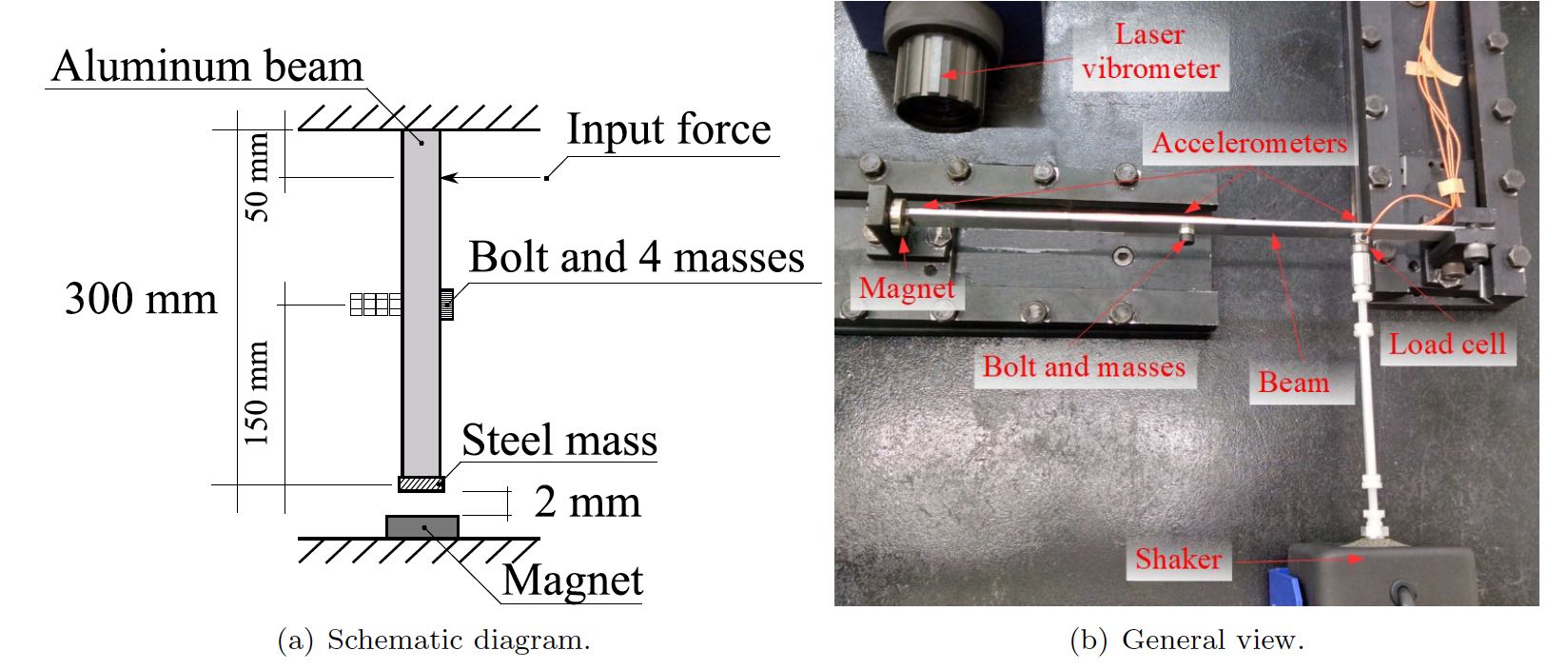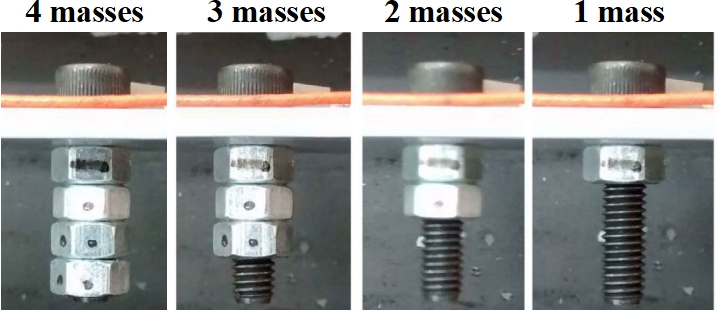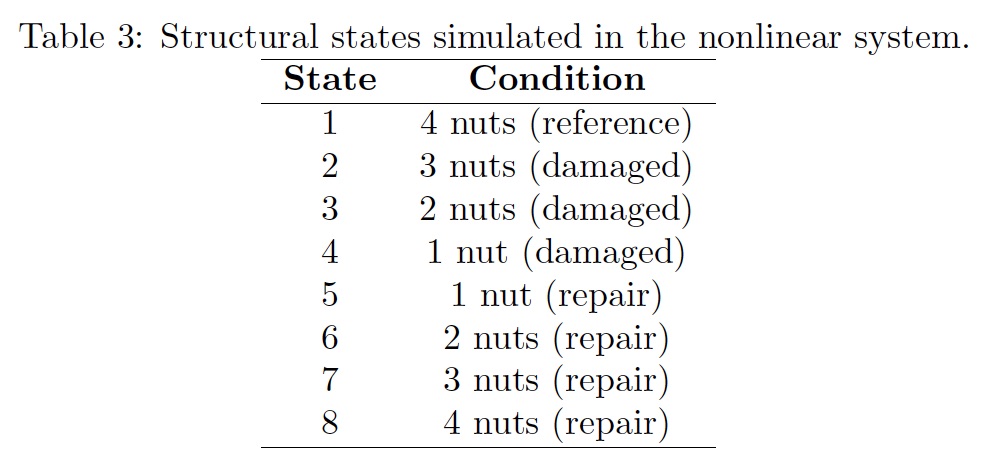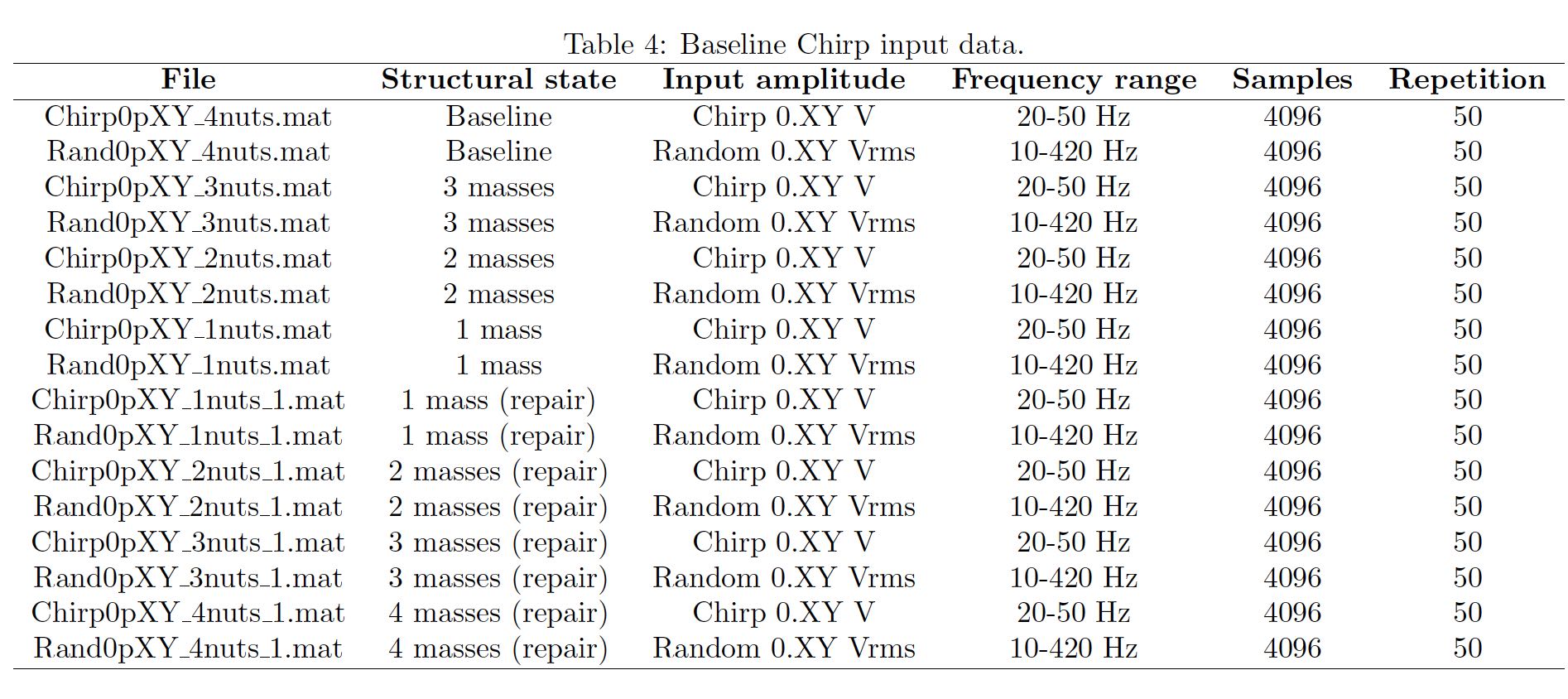To download the data set of a magneto-elastic system composed of a clamped beam interacting with a permanent magnet in a mono-stable configuration with hardening behavior:
https://forms.gle/o8XTcQZe5BiNo9PU7
The current structure consists of a magneto-elastic system composed of a clamped beam interacting with a permanent magnet in mono-stable configurations with hardening behavior. The experimental setup is composed of a cantilever aluminum beam with 300 mm x 19 mm x 3.2 mm. The structure has a small steel mass attached to the free end of the beam and a neodymium magnet with a 2 mm gap to the mass.
A small bolt with four masses (nuts) was placed in the middle of the beam to simulate small structural variations. Each mass has 2 grams.
The equipment, sensors, and actuators used for the experimental tests are:
The shaker was attached 50 mm distant from the clamp. Velocity was measured through the laser vibrometer in the free end of the beam. Three accelerometers were placed in: the driving point, the position of the bolt and the four masses, and in the free end of the beam.
Each experiment generated a mat file with the variables recorded during the modal tests. Table 1 shows the variables included in each file with the respective description.
Four different input signals were used to characterize the baseline condition of the structure ("healthy" state): chirp, random noise, sine, and stepped sine excitation:
The description of the files of these experiments is presented in Table 2. The character "0pXY" denotes Volts' input level, where "XY" represents the digits after the floating-point.
The masses were gradually removed from a total of 4 masses to simulate a structural variation. Table 3 shows the structural states simulated in the system, while the figure below exhibits a view of the bolt and nuts in the magneto-elastic system.
For the damage detection, only two signals were used to excite the nonlinear beam:
The description of the files of these experiments is presented in Table 4. The character "0pXY" denotes Volts' input level, where "XY" represents the digits after the floating-point.
The data are still available for non-commercial research under the following terms: (i) the SHM Lab at UNESP/Ilha Solteira should be acknowledged as the source of the data; (ii) in publications, relevant publications by members of the SHM Lab at UNESP/Ilha Solteira should be cited; (iii) this benchmark should be cited as UNESP-MAGNOLIA.
This dataset was used in these papers:
If you are using a LaTeX Editor, you can cite the papers above using these BibTeX citations:
@article{VILLANI2019463,
title = "Damage detection in an uncertain nonlinear beam based on stochastic Volterra series: An experimental application",
journal = "Mechanical Systems and Signal Processing",
volume = "128",
pages = "463 - 478",
year = "2019",
issn = "0888-3270",
doi = "https://doi.org/10.1016/j.ymssp.2019.03.045",
url = "http://www.sciencedirect.com/science/article/pii/S0888327019302250",
author = "Luis G.G. Villani and Samuel {da Silva} and Americo Cunha and Michael D. Todd",
}
@article{shiki2017application,
title={On the application of discrete-time Volterra series for the damage detection problem in initially nonlinear systems},
author={Shiki, Sidney B and da Silva, Samuel and Todd, Michael D},
journal={Structural Health Monitoring},
volume={16},
number={1},
pages={62--78},
year={2017},
publisher={SAGE Publications Sage UK: London, England}
url = "https://doi.org/10.1177/1475921716662142",
}
@mastersthesis{Tahara2019,
title={A study of the influence of nonlinear behavior on experimental modal analysis},
author={Tahara, Lucas Zanovello},
year={2019},
school ={Universidade Estadual Paulista (UNESP)}
note = {M.Sc. in Mechanical Engineering}
url = "http://hdl.handle.net/11449/183481",
}
@phdthesis{shiki2016application,
title={Application of Volterra series in nonlinear mechanical system identification and in structural health monitoring problems},
author={Shiki, Sidney Bruce},
year={2016},
school ={Universidade Estadual Paulista (UNESP)}
note = {Ph.D. in Mechanical Engineering}
url = "http://hdl.handle.net/11449/137761",
}
Creative Commons Attribution-NonCommercial-ShareAlike (CC-BY-NC-SA):
A creative commons license that bans commercial use and requires you to release any modified works under this license.
São Paulo Research Foundation (FAPESP), grant numbers 12/09135-3, 12/04757-6, 13/25148-0, and 15/03560-2, Brazilian National Council for Scientific and Technological Development (CNPq), and Brazilian Coordination for the Improvement of Higher Education Personnel (CAPES)-Finance Code 001 funded this experimental setup.







